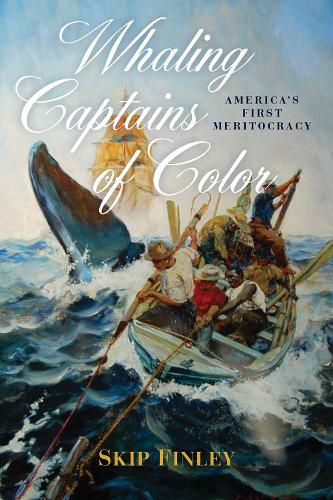Readings Newsletter
Become a Readings Member to make your shopping experience even easier.
Sign in or sign up for free!
You’re not far away from qualifying for FREE standard shipping within Australia
You’ve qualified for FREE standard shipping within Australia
The cart is loading…






Many historic houses decorating Skip Finley’s native Martha’s Vineyard were originally built by whaling captains. Whether in his village of Oak Bluffs, on the Island of Nantucket where whaling burgeoned, or New Bedford, which became the City of Light thanks to whaling, these magnificent homes testify to the money that was made from whaling. The triangle connecting Martha’s Vineyard to these areas and Eastern Long Island was the Middle East of its day. Whale wealth was astronomical, and endures in the form of land trusts, roads, hotels, docks, businesses, homes, churches and parks. Whaling revenues were invested into railroads and the textile industry. Millions of whales died in the 250 year enterprise, with more than 2,700 ships built for chasing, killing and processing whales. That story is well-told in books, some that have been bestsellers. What hasn’t been told is the story of whaling’s colorful leaders in an era when the only other option was slavery. Whaling was the first American industry to exhibit any diversity. A man got to be captain not because he was white or well connected, but because he knew how to kill a whale. Along the way he could learn navigation and reading and writing. Whaling presented a tantalizing alternative to mainland life. Working with archival records at whaling museums, in libraries, from private archives and interviews with people whose ancestors were whaling masters, Finley culls stories from the lives of 54 black whaling captains to create a portrait of what life was like for these leaders of color on the high seas. Each time a ship spotted a whale, a group often including the captain would jump into a small boat, row to the whale, and attack it, at times with the captain delivering the killing blow. The first, second or third mate, and boat steerer could eventually have opportunities to move into increasingly responsible roles. Finley explains how this skills-based system propelled captains of color to the helm.
Readers will meet an improbable, diverse, engaging cast of characters: slaves and slavers, abolitionists, Quakers, British, killers and cannibals, deserters and gamblers, gold miners, inventors and investors, cooks and crooks, and of course the whales, the latter of whom seemingly had personalities of their own. The book concludes as facts and factions conspire to kill the industry, including wars, weather, bad management, poor judgment, disease, obsolescence and a non-renewable natural resource. Ironically, the end of the Civil War allowed the African Americans who were captains to exit the difficult and dangerous occupation and make room for the Cape Verdean who picked up the mantle, literally to the end of the industry.
$9.00 standard shipping within Australia
FREE standard shipping within Australia for orders over $100.00
Express & International shipping calculated at checkout
Many historic houses decorating Skip Finley’s native Martha’s Vineyard were originally built by whaling captains. Whether in his village of Oak Bluffs, on the Island of Nantucket where whaling burgeoned, or New Bedford, which became the City of Light thanks to whaling, these magnificent homes testify to the money that was made from whaling. The triangle connecting Martha’s Vineyard to these areas and Eastern Long Island was the Middle East of its day. Whale wealth was astronomical, and endures in the form of land trusts, roads, hotels, docks, businesses, homes, churches and parks. Whaling revenues were invested into railroads and the textile industry. Millions of whales died in the 250 year enterprise, with more than 2,700 ships built for chasing, killing and processing whales. That story is well-told in books, some that have been bestsellers. What hasn’t been told is the story of whaling’s colorful leaders in an era when the only other option was slavery. Whaling was the first American industry to exhibit any diversity. A man got to be captain not because he was white or well connected, but because he knew how to kill a whale. Along the way he could learn navigation and reading and writing. Whaling presented a tantalizing alternative to mainland life. Working with archival records at whaling museums, in libraries, from private archives and interviews with people whose ancestors were whaling masters, Finley culls stories from the lives of 54 black whaling captains to create a portrait of what life was like for these leaders of color on the high seas. Each time a ship spotted a whale, a group often including the captain would jump into a small boat, row to the whale, and attack it, at times with the captain delivering the killing blow. The first, second or third mate, and boat steerer could eventually have opportunities to move into increasingly responsible roles. Finley explains how this skills-based system propelled captains of color to the helm.
Readers will meet an improbable, diverse, engaging cast of characters: slaves and slavers, abolitionists, Quakers, British, killers and cannibals, deserters and gamblers, gold miners, inventors and investors, cooks and crooks, and of course the whales, the latter of whom seemingly had personalities of their own. The book concludes as facts and factions conspire to kill the industry, including wars, weather, bad management, poor judgment, disease, obsolescence and a non-renewable natural resource. Ironically, the end of the Civil War allowed the African Americans who were captains to exit the difficult and dangerous occupation and make room for the Cape Verdean who picked up the mantle, literally to the end of the industry.